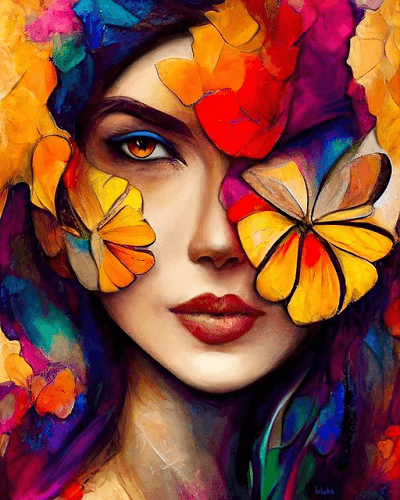Beginning on an Aesthetic Journey Via the Lyrical Interpretations of Nature in Stylist Landscapes
Each brushstroke, each play of light and darkness, and each color option in their works speaks volumes about the artists' deep link to nature and their ability to equate its elegance onto the canvas. As we explore the lyrical analyses of nature in Impressionist landscapes, we are invited to submerse ourselves in a globe where fact and emotion intertwine, providing a look into the artists' extensive recognition for the all-natural globe.
The Exciting Brushstrokes of Claude Monet
Claude Monet's mastery of brushstrokes transcends mere technique, imbuing his landscapes with an ethereal high quality that mesmerizes and captivates audiences - trump art. His innovative use shade and light, integrated with his distinctive brushwork, produces a sense of activity and life within his paints. Monet's renowned series of jobs showing water lilies and his renowned haystacks display his capacity to catch the short lived results of light and environment

Enjoying Light and Shadow With Camille Pissarro
Embodying a similar reverence for the interaction of light and shadow, Camille Pissarro's artistic vision unravels as a harmonious exploration of the environment's luminescent nuances. Pissarro, an essential number in the Impressionist motion, masterfully captured the dynamic connection between light and darkness in his landscapes. His experienced usage of color and brushwork permitted him to convey the subtle shifts in light that specify various times of day and seasons.
Pissarro's paintings frequently include dappled sunshine infiltrating fallen leaves, casting intricate patterns of light and shadow on the earth below. In jobs such as "Hoar Frost, the Impact of Snow, Pontoise," Pissarro skillfully portrays the crisp illumination of winter season sunshine juxtaposed with the great shadows that specify the snowy landscape. By welcoming both light and shadow in his compositions, Pissarro invites audiences to submerse themselves in the natural charm and transient impacts of light on the planet around them.

Through Pissarro's jobs, we are reminded of the transformative power of light and shadow, welcoming us to stop and appreciate the fleeting minutes of appeal present in the everyday landscapes that border us.
A Symphony of Colors by Edgar Degas
Edgar Degas coordinates a dynamic symphony of shades in his skillful artworks, instilling his structures with a vibrant interaction of tones that captivate the viewer's gaze. Known mostly for his ballet professional dancers and intimate scenes of Parisian life, Degas skillfully adjusted shades to convey mood and movement in his paintings. trump art. His usage of vibrant, contrasting colors and refined tonal variants developed a feeling of deepness and vibrancy within his works
Degas' shade palette typically was composed of abundant blues, deep environment-friendlies, and cozy oranges, which he applied with certain brushstrokes to record the significance of his topics. link Whether depicting a ballerina mid-performance or a group of buddies conversing at a coffee shop, Degas' colors not only depicted the scene yet additionally evoked a sense of feeling and power.
In Addition, Degas' experimentation with light and darkness added an added layer of complexity to his color structures, enhancing the total atmosphere of his paintings (trump art). Through his skilled control of color, Degas created a visual symphony that remains to reverberate with visitors today
Exploring Nature's Peacefulness With Berthe Morisot
Berthe Morisot's creative vision provides a serene departure from the vivid shade harmonies of Edgar Degas, as she captures the peace of nature in her evocative landscapes. Understood for her delicate brushwork and intimate portrayals of daily life, Morisot's landscapes radiate a sense of tranquility and harmony.
Morisot's paints usually feature soft, low-key tones that communicate a sense of calmness and tranquility. Her jobs, such as "The Cradle" and "Summer season's Day," showcase her capacity to capture the subtle elegance of nature in such a way that is both reflective and soothing to the audience.
Unlike a few of her Impressionist equivalents who focused on vibrant make-ups and bold colors, Morisot chose to develop mild, introspective scenes that welcome the audience to stop and reflect. Through her masterful use light and shadow, Morisot develops a sense of harmony that reverberates with the customer on a deep psychological degree.
The Psychological Landscapes of Vincent Van Gogh
Vincent Van Gogh's landscapes vividly communicate a depth of feeling via their dynamic brushwork and expressive usage of shade. The Dutch post-impressionist artist is renowned for his capability to catch extreme and raw emotions in his paints, transcending standard depictions of nature. Van Gogh's turbulent personal life, marked by mental health and wellness battles, substantially influenced his art, instilling his landscapes with a recommended you read feeling of anxiousness, melancholy, or liveliness.
In jobs such as "Starry Evening" and "Wheatfield with Crows," Van Gogh's swirling brushstrokes and lively shade choices stimulate a profound emotional feedback from audiences. The unstable skies and flustered landscapes in his paints show his inner chaos and psychological turbulence, welcoming audiences to explore the complexities of his psyche.
Van Gogh's distinct visual language, defined by exaggerated point of views and vibrant usage of color, creates landscapes that resonate with customers on a deeply psychological level. Through his art, Van Gogh invites us to see nature not equally as an exterior truth yet as a mirror of our innermost sensations and emotions.
Verdict
To conclude, the impressionist landscapes of artists such as Claude Monet, Camille Pissarro, Edgar Degas, Berthe Morisot, and Vincent Van Gogh supply a special and exciting aesthetic analysis of nature. Via their use brushstrokes, color, emotion, and light, these artists have produced a harmony of photos that stimulate a feeling of calmness and beauty in the environment. Their jobs remain to inspire and charm visitors with their lyrical interpretations of the view landscapes around us.
Each brushstroke, each play of light and darkness, and each shade selection in their jobs speaks quantities concerning the artists' deep connection to nature and their ability to convert its appeal onto the canvas. His cutting-edge usage of color and light, combined with his distinct brushwork, develops a sense of motion and life within his paints. His skilled usage of color and brushwork enabled him to convey the refined shifts in light that define different times of day and seasons.
